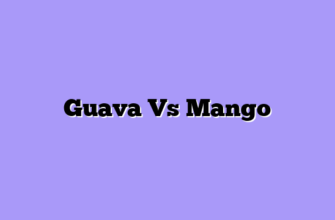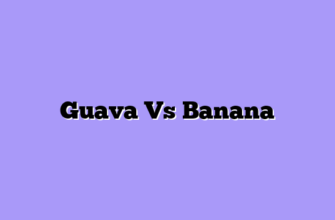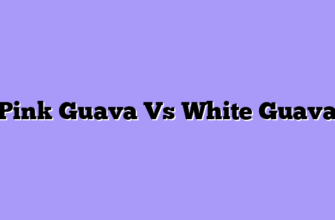Guava and passion fruit are both tropical fruits with distinct flavors and nutritional profiles. Guava, with its sweet and slightly tart taste, is known for its high vitamin C content. Passion fruit, on the other hand, boasts a tangy and aromatic flavor, rich in antioxidants and fiber.
Taste and Flavor Profiles
Guava and passion fruit, both tropical fruits, offer distinct and alluring flavor profiles that have captivated taste buds worldwide. While they share a common origin in the warm, humid regions of the Americas, their unique characteristics set them apart in the realm of taste.
Guava, with its diverse varieties, presents a spectrum of flavor experiences. The most common, the common guava, boasts a sweet and slightly tart flavor, reminiscent of a combination of pear and strawberry. Its flesh, depending on the variety, can range from white to pink to red, each hue contributing a subtle nuance to the overall taste. The guava’s aroma, often described as floral and slightly musky, adds another layer of complexity to its sensory appeal.
Passion fruit, on the other hand, offers a more intense and tangy flavor profile. Its vibrant purple skin encases a pulpy, seed-filled interior that bursts with a sweet and sour combination. The flavor is often described as a blend of citrus, tropical fruits, and a hint of floral notes. The seeds, while edible, contribute a slightly crunchy texture and a subtle bitterness that balances the sweetness of the pulp.

Passion fruit, with its intense and tangy flavor, is often used as a flavor enhancer. Its juice is a popular ingredient in cocktails, smoothies, and sorbets, adding a vibrant burst of tropical flavor. Its seeds, while not as commonly consumed as the pulp, can be used as a garnish or added to baked goods for a textural contrast.
Beyond their individual flavor profiles, guava and passion fruit can be combined to create unique and delicious culinary experiences. The sweetness of guava can balance the tanginess of passion fruit, resulting in a harmonious blend of flavors. This combination is often seen in desserts, drinks, and even savory dishes, showcasing the versatility of these tropical fruits.
Nutritional Content and Health Benefits
Guava and passion fruit, both tropical fruits, are renowned for their vibrant flavors and nutritional richness. While they share similarities in their origins and popularity, they also possess distinct characteristics in terms of their nutritional content and health benefits.
Guava, a fruit native to Mexico and Central America, is a powerhouse of vitamins and minerals. It is particularly rich in vitamin C, an essential antioxidant that supports immune function and collagen production. A single guava can provide more than twice the daily recommended intake of vitamin C. Additionally, guava is a good source of dietary fiber, which aids digestion and promotes satiety. Its high potassium content helps regulate blood pressure, while its folate content is crucial for cell growth and development.
Passion fruit, on the other hand, hails from South America and is known for its tangy, sweet flavor. While it may not boast the same vitamin C content as guava, it is an excellent source of vitamin A, which is essential for vision, skin health, and immune function. Passion fruit is also rich in antioxidants, including polyphenols and flavonoids, which have been linked to various health benefits, such as reducing inflammation and protecting against chronic diseases.
In terms of their health benefits, both guava and passion fruit offer a range of advantages. Guava’s high vitamin C content makes it a potent immune booster, while its fiber content aids in weight management and digestive health. Its potassium content helps regulate blood pressure, and its folate content is crucial for pregnant women and those trying to conceive.
Passion fruit, with its abundance of antioxidants, is believed to have anti-inflammatory properties and may help protect against heart disease and cancer. Its vitamin A content supports vision and skin health, while its fiber content promotes digestive regularity.
While both fruits offer a wealth of nutrients and health benefits, their specific advantages vary. Guava stands out for its high vitamin C content and its role in immune support, while passion fruit shines with its antioxidant profile and potential benefits for heart health and inflammation.
Culinary Uses and Recipes
Guava, with its firm flesh and sweet-tart flavor, lends itself well to both sweet and savory applications. Its versatility shines in desserts, where it can be incorporated into jams, jellies, pies, and even ice cream. The guava’s subtle tang balances the sweetness, creating a harmonious flavor profile. In savory dishes, guava adds a touch of acidity and complexity to salsas, chutneys, and marinades. Its firm texture also makes it an excellent ingredient for grilling or roasting, adding a smoky depth to the flavor.
Passion fruit, on the other hand, boasts a more intense and tangy flavor, often described as a blend of citrus and floral notes. Its juicy pulp, filled with tiny black seeds, is a popular ingredient in beverages, particularly juices and smoothies. The passion fruit’s vibrant acidity adds a refreshing twist to cocktails and mocktails, while its unique aroma enhances the flavor of desserts like cheesecakes and mousses. Its seeds, though edible, can be strained out for a smoother texture.

Beyond their individual culinary uses, guava and passion fruit can be combined to create unique and flavorful dishes. The combination of guava’s sweetness and passion fruit’s tanginess creates a harmonious balance that enhances the overall flavor profile. Guava and Passion Fruit Salsa, a vibrant and refreshing condiment, is a perfect example of this synergy. The guava’s sweetness complements the passion fruit’s acidity, creating a delightful balance of flavors.
Growing and Harvesting
Guava trees, belonging to the myrtle family, are relatively easy to cultivate. They prefer well-drained soil and ample sunlight, flourishing in USDA hardiness zones 9-11. Propagation is typically achieved through seeds or cuttings, with seedlings taking longer to bear fruit than cuttings. Guava trees can reach heights of 15-30 feet, requiring adequate space for growth. Once established, they are relatively low-maintenance, requiring regular watering and occasional fertilization.
Harvesting guavas is a simple process. The fruits ripen on the tree, changing color from green to yellow or red depending on the variety. They are ready for picking when they yield slightly to gentle pressure. Guavas can be enjoyed fresh, juiced, or used in jams, jellies, and other culinary creations.
Passion fruit, on the other hand, is a vine that requires a sturdy support system to climb. It thrives in USDA hardiness zones 9-11, preferring well-drained soil and full sun. Propagation is typically done through seeds or cuttings, with seedlings taking longer to produce fruit than cuttings. Passion fruit vines can grow rapidly, reaching lengths of 20-30 feet, requiring regular pruning to maintain their shape and encourage fruit production.
Harvesting passion fruit involves identifying the ripe fruits, which turn from green to purple or yellow depending on the variety. The fruits are ready for picking when they feel firm and slightly soft to the touch. Passion fruit can be enjoyed fresh, juiced, or used in desserts, sauces, and other culinary applications.
While both guava and passion fruit offer unique flavors and benefits, their growing and harvesting methods differ significantly. Guava trees require more space and are relatively low-maintenance, while passion fruit vines need a support system and regular pruning. However, both fruits are relatively easy to cultivate and offer a rewarding experience for home gardeners.
The choice between guava and passion fruit ultimately depends on personal preferences and available space. Guava trees provide a more traditional fruit-bearing experience, while passion fruit vines offer a more dynamic and visually appealing option. Regardless of the choice, both fruits offer a taste of the tropics and a rewarding experience for the home gardener.
Availability and Cost
Guava, a fruit native to Central America and the Caribbean, is widely cultivated in tropical and subtropical regions. Its availability varies depending on the specific variety and location. In regions where guava is grown locally, it is typically readily available year-round, often sold at local markets and roadside stalls. However, in areas where guava is imported, availability may be seasonal, with peak supply during the summer months.
Passion fruit, on the other hand, is native to South America and is now cultivated in various tropical and subtropical regions. Its availability is also influenced by seasonality, with peak production occurring during the summer months in many regions. However, due to its popularity and global demand, passion fruit is often available year-round in many markets, particularly in processed forms such as juice and pulp.

Furthermore, the cost of guava and passion fruit can also be influenced by their form. Fresh fruits are typically more expensive than processed forms such as juice, pulp, or concentrates. This is because processing reduces the cost of transportation and storage, making these products more accessible to consumers.
In terms of price comparison, guava is generally considered to be more affordable than passion fruit. This is partly due to its wider availability and lower demand compared to passion fruit. However, the price difference can vary depending on the specific variety, quality, and market conditions.
In conclusion, the availability and cost of guava and passion fruit are influenced by a complex interplay of factors, including seasonality, geographical location, and market demand. While guava is generally more readily available and affordable, passion fruit is often available year-round due to its global demand. Ultimately, the choice between these two fruits depends on individual preferences, availability, and budget.
Q&A
## Guava vs Passion Fruit: 5 Questions & Answers
**1. What is the difference in taste?**
Guava has a sweet and slightly tart flavor, while passion fruit is tangy and tropical with a slightly acidic taste.
**2. Which fruit is higher in Vitamin C?**
Passion fruit is higher in Vitamin C than guava.
**3. Which fruit is better for weight loss?**
Both fruits are low in calories and high in fiber, making them good choices for weight loss. However, guava is slightly lower in calories.
**4. Which fruit is more versatile in cooking?**
Passion fruit is more versatile in cooking, as it can be used in juices, desserts, sauces, and even savory dishes. Guava is typically eaten fresh or used in jams and jellies.
**5. Which fruit is more readily available?**
Guava is more readily available in tropical regions, while passion fruit is more common in subtropical areas. Availability may vary depending on location.








